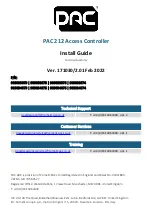
handling circuitry. The secondary channel can be enabled where data is placed into the DMC-
1600 FIFO buffer.
General I/O
The DMC-1600 provides interface circuitry for 8 bidirectional, optoisolated inputs, 8 TTL outputs
and 8 analog inputs with 12-Bit ADC (16-bit optional). The general inputs can also be used as
high speed latches for each axes. A high speed encoder compare output is also provided.
System Elements
As shown in Fig. 1.2, the DMC-1600 is part of a motion control system which includes amplifiers,
motors and encoders. These elements are described below.
Computer
DMC-1600 Controller
Amplifier (Driver)
Power Supply
Encoder
Motor
Figure 1.2 - Elements of Servo systems
Motor
A motor converts current into torque which produces motion. Each axis of motion requires a
motor sized properly to move the load at the required speed and acceleration. (Galil's "Motion
Component Selector" software can help you with motor sizing). Contact Galil at 800-377-6329 if
you would like this product.
The motor may be a step or servo motor and can be brush-type or brushless, rotary or linear. For
step motors, the controller can be configured to control full-step, half-step, or microstep drives.
An encoder is not required when step motors are used.
Amplifier (Driver)
For each axis, the power amplifier converts a +/-10 Volt signal from the controller into current to
drive the motor. For stepper motors, the amplifier converts step and direction signals into current.
The amplifier should be sized properly to meet the power requirements of the motor. For
brushless motors, an amplifier that provides electronic commutation is required or the controller
must be configured to provide sinusoidal commutation. The amplifiers may be either pulse-width-
modulated (PWM) or linear. They may also be configured for operation with or without a
tachometer. For current amplifiers, the amplifier gain should be set such that a 10 Volt command
generates the maximum required current. For example, if the motor peak current is 10A, the
amplifier gain should be 1 A/V. For velocity mode amplifiers, 10 Volts should run the motor at
the maximum speed.
4
•
Chapter 1 Overview
DMC-1600













































